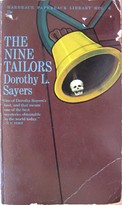
| Series: | Peter Wimsey #11 |
| Publisher: | Harbrace |
| Copyright: | 1934 |
| Printing: | 1962 |
| Format: | Mass market |
| Pages: | 311 |
This is one of Sayers's Lord Peter Wimsey mysteries and is fairly late in the series. Since it's the first one I've read, I can't tell you for certain if you lose anything by reading it out of order, but it seem to me to stand fine on its own. The only minor complaint I had that may be related to reading out of order was that there wasn't much characterization or personal detail about Wimsey, which makes sense for a late-series book where most readers are already familiar with the character.
The Nine Tailors opens with Wimsey wrecking his car in a snowstorm in the fen country of East Anglia on New Year's Eve. He takes shelter with the rector of Fenchurch St. Paul, who has a problem of his own: a rash of illness in the area has put into jeopardy his plans to ring in the new year, literally, with an all-night performance of Kent Treble Bob on the church bells. Wimsey, it so happens, is an experienced bell-ringer and is recruited to stand in for one of the sick ringers, which he does with enthusiasm and great success. The New Year is marred only by the death of the wife of the local squire, a man who had fallen on hard times after having to repay the theft of a very expensive necklace from a visitor by his butler twenty years previous. The necklace was never recovered, and of course forms the basis of the mystery of the book.
This opening is mildly interesting for the introduction of change ringing, but I must admit I found most of it horribly dull. Fifty pages in, with the unknown location of the stolen necklace the only mystery and bogged down by quite a lot of description of the local area, I wasn't sure I wanted to continue. Sayers tends towards long paragraphs full of description, and knowing that it's a mystery, I was also doing myself a disservice by trying to read closely and remember a lot of irrelevant detail (completely unnecessarily, as it turned out).
Thankfully, about this point is when the story picks up considerably. Sir Henry dies, following his wife, and his wife's grave is reopened to bury him alongside, at which point another body is discovered in the grave. The man has been brutalized to make him nearly impossible to identify, but apparently was already dead when that was done. Wimsey is called back in and tries to determine who killed him and why, finding links to the earlier theft of the necklace. The story picks up a satisfying set of twists, confusions of identity, and multiple players with competing motives. Even better from my perspective, memory of all the detailed description is not required to follow the mystery. As Wimsey unravels the mystery, the characters lay out portions of the story for the reader in conversations that are almost flashbacks.
Stylistically, it took me about a hundred pages to get used to Sayers, and throughout the pacing was a little slower than I would have preferred. Sayers adds quite a bit of detail about local life and significant local personalities which is either extraneous or entertaining embellishment, depending on one's preferences for this sort of style. I found the emotional response of the people oddly muted, particularly given the events near the end of the book, but I suspect that's also stylistic, something else for the reader to get used to.
The mystery functioned very well structurally for me. It wasn't the sort of mystery where I thought the author was daring me to solve it before the detective, nor did it play games with partial revealed facts or a protagonist who was portrayed as one step ahead of everyone. It's somehow friendlier and more comfortable than other mysteries I've read, with careful attention paid to bringing the reader along with Wimsey's thought processes. I thought it was somewhat mechanical, though: there are multiple layers, put together with attention to structural detail, but I never felt much emotional engagement or sense of dramatic tension. This is not necessarily a drawback, depending on what sort of story one is in the mood for.
While this isn't one of my favorite books, I enjoyed it well enough that I'll keep reading Sayers. I suspect one's enjoyment will depend largely on how entertaining one finds the change-ringing geeking, which is built deeply into the plot in some surprising ways. I wish the story carried a bit more emotional punch, but it's fun once it gets going.
Reviewed: 2009-08-10